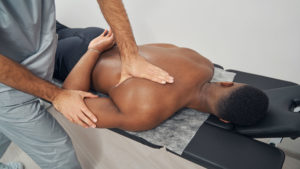Introduction
A chiropractor can assist you in correcting poor posture by identifying and treating the underlying cause of your difficulties. It is possible to start sitting and standing up straight without having to constantly remind yourself if the underlying cause of your poor posture is addressed. Take a look at some of the advantages of having better posture–and how a chiropractor may assist you in achieving it.
Can a chiropractor fix posture?
The ability to maintain good posture, which is also known as a neutral spine, can help you avoid back pain and injury. Your health, mood, and self-confidence will all improve as a result, as will how others perceive you. Not only that but maintaining a professional demeanor can help to keep your organs healthy and combat the physical signs of aging.
A chiropractor can assist you whether you are suffering from back and shoulder pain or simply want to improve your posture for a better quality of life in general. Chiropractors can notice a postural imbalance. For example, one of your shoulders being higher can have major consequences for the spine and the rest of your body over time.
Furthermore, a chiropractor can improve slouching or forward head carriage, which can strain the spine, making it critical to maintain good posture. A chiropractor can improve hunchback, uneven hips, pelvis, scoliosis, kyphosis, and damage to the spine’s natural curvature, which will naturally improve posture.
Why is good posture important?
Standing, walking, sitting, and lying down with proper posture reduces the strain and tension placed on your muscles and ligaments, allowing you to perform more with less. As a result, it can help you avoid future problems with your back and neck and improve your overall well-being while going about your everyday activities.
Although the health benefits of excellent posture are fairly evident, you should be aware of several less visible health benefits to mitigate future issues. Good posture can help with reducing the amount of stress placed on ligaments, hence reducing the likelihood of damage. Also, good posture can prevent muscle strain, overuse, and soreness by exercising regularly.
Because muscles are used more efficiently with good posture, you can conserve energy. Additionally, proper posture reduces the likelihood of abnormal joint wear. Correct posture can even reduce negative mental health and digestive issues and improve self-confidence.
What are the causes of bad posture?
Unfortunately, there are a variety of circumstances that can interfere with excellent posture. Bad posture can be caused by various factors, including the influence of gravity on our bodies daily. Bad posture can also emerge as a result of an injury, a sickness, or genetics—factors that, for the most part, are out of your control.
Additionally, a combination of these elements is fairly prevalent. Some of the most common causes are injury and associated muscle spasms. Next, muscle tension and weakness, daily habits, mental health issues, shoes, purses, wallets, heredity, and genetics can all lead to poor posture. Even whiplash from a car accident can cause problems with posture.
Men should not keep their wallets in their back pockets as this can throw their hips and spine off balance leading to great pain. Women tend to have heavy purses or bags on one shoulder, throwing off their shoulders and causing problems. Add in high heels, and the problem becomes worse.
Working in front of a computer or playing on a phone can cause issues with a phone up to your ear, throwing off your shoulders. Next, sleeping in the wrong position or on a bad mattress can lead to bad posture. Finally, extra weight puts more pressure on the bones and can lead to improper posture.
When should you go to a chiropractor for bad posture?
The best time to see a chiropractor is sooner rather than later. If possible, see a chiropractor before an issue arises to prevent problems down the road. If you heed their advice, chiropractors can help prevent inappropriate spinal movements to help you enjoy life with less pain or no pay!
However, if you find your posture is off, you can start seeing a chiropractor at any time. In addition, for those who have recently been in a car accident, sports injury, or other injuries, see a chiropractor as soon as possible to speed up recovery and reduce the chances of extensive damage to the spine.
Lastly, see a chiropractor if you experience headaches, muscle or joint pain, sit for a long period every day, have back pain, and if your shoe soles are wearing out differently. Sharp shooting pains in the leg and limited range of motion also indicate it’s time to make an appointment. Putting off seeing a chiropractor has ramifications for now and the future leading to discomfort.
What are the different types of postural issues?
Several types of posture problems can lead to discomfort and pain. The most common are:
Kyphosis is an excessive curvature of the upper back (thoracic spine) with forward rounded shoulders. This postural issue is also called a hunchback or slouch. As your spine bones deteriorate with age, osteoporosis can cause your shoulders to round. It is common in older women. Degeneration of spinal discs or vertebrae are also age-related factors. Younger people can get kyphosis from heredity, genetics, polio, Scheuermann’s illness, infection, or chemotherapy or radiation for cancer.
Flatback occurs when the lower spine’s natural curve loses some of its curvatures. As a result, you stoop forward with a straight lower back. It can be inherited or caused by back surgery or degenerative spine disorders such as inflammatory arthritis (ankylosing spondylitis), disc degeneration, and vertebral compression. Long-term standing with a flat back can be unpleasant.
Swayback occurs when the hips and pelvis lean forward in front of the body’s midline. Your lower back is curved inward in this position. You appear to be leaning back when standing up, with your stomach and posterior protruding. Sitting too much might cause swayback by tightening the back muscles. Long-term sitting can damage your abdominal and gluteal muscles. In both circumstances, the stabilizing core muscles weaken. Obesity, injuries, neuromuscular disorders, and anomalies of the spine and vertebrae can also cause swayback.
Forward head posture occurs when your ears are in front of your vertical midline. Your ears and shoulders should be aligned with your vertical midline. Forward head posture is sometimes known as tech neck or text neck. A hunched over a phone, computer, or steering wheel if you drive regularly. It can also be caused by aging and loss of upper body muscle strength.
How long does it take a chiropractor to fix bad posture?
Adults typically require 2-3 weeks of manual spinal manipulation to correct any issues they may be experiencing, with two spinal corrections per week. After one week of regular alignment, the therapy is reduced to once a week for another 2-3 weeks. After the second round of treatments, you should notice a considerable improvement in your back’s alignment.
Your back should now stay aligned for a month, and then the chiropractor will reassess your spine. After three months of stabilization, you will be relocated and assessed for therapy. Symptoms should go dormant after three months of healing and stability.
Because everyone reacts differently to manipulation, the three-month healing process is not for everyone! People with more stress may require more chiropractic care or vice versa. There is no one-size-fits-all when it comes to spinal manipulation, which is why good chiropractors will create a custom plan for each person.
What are ways to improve posture at home?
It’s easier than you think to fix posture at home. Exercises can help, including pilates and yoga, focusing on posture movements and general health. A posture belt or posture corrector can help you maintain better posture. Most importantly, you need to be mindful of your posture and correct problems as they arise.
Other methods that can help are maintaining a healthy weight, wearing low heel shoes, and staying active. If you work in front of a computer or at a desk all day, set up your desk in a way that you can sit up properly and reduce curvatures of the spine, such as slouching.
Take breaks often and try to reduce stress that can lead to tense shoulders. Furthermore, be mindful of your posture when on your phone or tablet, as most people tend to stretch and tilt their neck, which leads to strain (and necklines too). Last of all, good sleep on a supportive mattress and pillow will help improve posture at home.
Portland Wellness Care uses western and eastern therapies to address health concerns, including poor posture that can lead to pain and discomfort. We also have a chiropractor on staff who can help with a range of issues related to the spine. When you visit our facility, you will be offered a treatment plan tailored to your individual needs.
Conclusion
Your posture refers to more than just how you hold yourself when you walk. The consequences of poor posture can negatively impact your physical, mental, and emotional well-being. Self-correcting poor posture takes time and effort. You have to do more than remind yourself to stand up straighter will not suffice if there are underlying issues causing your poor posture.
A chiropractic professional can assist you in improving poor posture, whether the problem is caused by an injury, stress, or anything in between. You should seek treatment from a licensed chiropractor if you are experiencing back pain or other symptoms of poor posture as soon as possible. Call Portland Wellness Care today and schedule an appointment.
Explore More Blogs for Portland Wellness Care:










